LASER stands for Light Amplification by Stimulated Emission of Radiation. LASER is a narrow beam of light of a single wavelength (monochromatic) in which each wave is in phase (coherent) with others near it.
Laser apparatus
Laser apparatus is a device that produces an intense concentrated, and a highly parallel beam of coherent light.
Atom composed of a nucleus and electron cloud. If an incident photon is energetic enough, it may be absorbed by an atom, raising the latter to an excited state. It was pointed out by Einstein in 1917 that an excited atom can be revert to the lowest state via two distinctive mechanisms:
- Spontaneous Emission
- Stimulated Emission
1. Spontaneous emission
- Each electron can drop back spontaneously to the ground state emitting photons.
- Emitted photons bear no incoherent. It varies in phase from point to point and from moment to moment.
- e.g. emission from a tungsten lamp.
2. Stimulated emission
- Each electron is triggered into emission by the presence of electromagnetic radiation of the proper frequency. This is known as stimulated emission and it is a key to the operation of a laser.
- e.g. emission from Laser

Absorption
Let us consider an atom that is initially in level 1 and interacts with an electromagnetic wave of frequency n. The atom may now undergo a transition to level 2, absorbing the required energy from the incident radiation. This is a well-known phenomenon of absorption.

According to Boltzmann’s statistics, if a sample has a large number of atoms, No, at temperature T, then in thermal equilibrium the number of atoms in energy states E1 and E2 are:
N1 = No e−E1/kT
N2 = No e−E2/kT
- If E1 < E2 Then N1 > N2
- If E1 < E2 and N1 < N2 This is called “Population Inversion“.
Population inversion
Generally, electrons tend to (ground state). What would happen if a substantial percentage of atoms could somehow be excited into an upper state leaving the lower state all empty? This is known as a population inversion. An incident of a photon of proper frequency could then trigger an avalanche of a stimulated photon- all in phase (Laser).
- Consider a gas enclosed in a vessel containing free atoms having a number of energy levels, at least one of which is Metastable.
- By shining white light into this gas, many atoms can be raised, through resonance, from the ground state to excited states.
E1 = Ground state,
E2 = Excited state (short life time ns),
E3 = Metastable state (long life time from ms to s).

To generate laser beam three processes must be satisfied:-
- Population inversion
- Stimulated emission
- Pumping source

Pumping Sources
1. Optical Pumping: Suitable For Liquid And Solid Laser Because They Have Wide Absorption Bands.
2. Electric Pumping: Suitable For Gas Laser Because They Have Narrow Absorption Band.
3. Chemical Reaction.
Types of lasers
According to the active material
solid-state, liquid, gas, excimer or semiconductor lasers.
According to the wavelength
Infra-red (IR), Visible, Ultra-violet (UV) or X-ray Lasers.
Solid-state lasers have lasing material distributed in a solid matrix (such as ruby or Nd-YAG). Flash lamps are the most common power source. The Nd-YAG laser emits infrared light at 1.064 nm.
Semiconductor lasers, sometimes called diode lasers, are p-n junctions. Current is the pump source. Applications: laser printers or CD players.
Dye lasers use complex organic dyes, such as Rhodamine 6G, in liquid solution or suspension as lasing media. They are tunable over a broad range of wavelengths.
Gas lasers are pumped by a current. Helium-Neon (He-Ne) lasers in the visible and IR. Argon lasers in the visible and UV. CO2 lasers emit light in the far-infrared (10.6 mm) and are used for cutting hard materials.
Excimer lasers: (from the terms excited and dimers) use reactive gases, such as chlorine and fluorine, mixed with inert gases such as argon, krypton, or xenon. When electrically stimulated, a pseudo molecule (dimer) is produced. Excimers laser in the UV.
Solid-state Laser
- Example: Ruby Laser
- Operation wavelength: 694.3 nm (IR)
- 3 level system: absorbs green/blue
- Gain Medium: crystal of aluminum oxide (Al2O3) with a small part of atoms of aluminum is replaced with Cr3+ ions.
- Pump source: flash lamp
- The ends of ruby rod serve as laser mirrors.
Ruby Laser
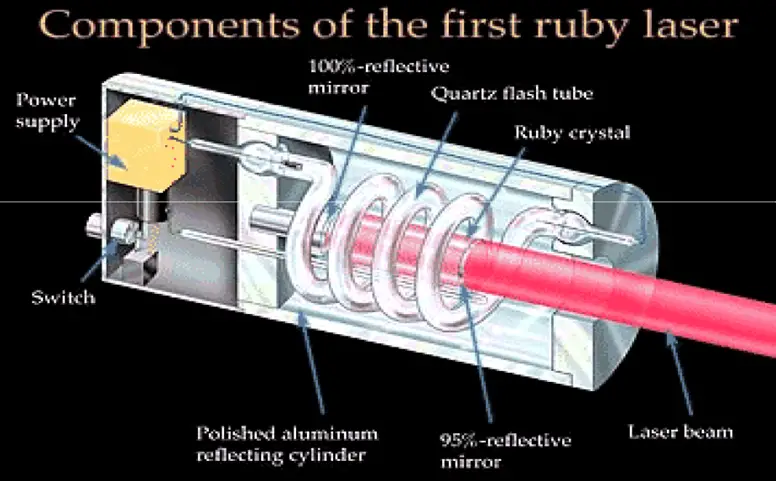
How Ruby laser works?
1. High-voltage electricity causes the quartz flash tube to emit an intense burst of light, exciting some of Cr3+ in the ruby crystal to higher energy levels.
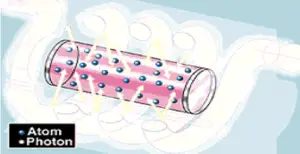
2. At a specific energy level, some Cr3+ emit photons. At first, the photons are emitted in all directions. Photons from one Cr3+ stimulate emission of photons from other Cr3+ and the light intensity is rapidly amplified.
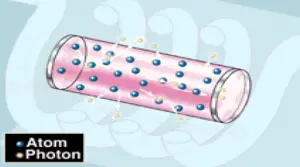
3. Mirrors at each end reflect the photons back and forth, continuing this process of stimulated emission and amplification.
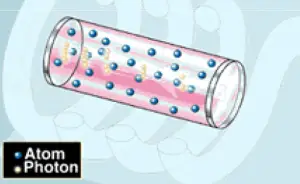
4. The photons leave through the partially silvered mirror at one end. This is laser light.
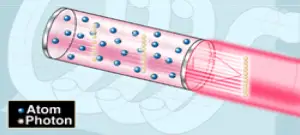
High-Level Lasers
- Surgical Lasers
- Hard Lasers
- Thermal
- Energy (3000-10000) mW
Low-Level Lasers
- Medical Lasers
- Soft Lasers
- Subthermal
- Energy (1-500) mW
- Therapeutic (Cold) lasers produce a maximum output of 90 mW or less (600-1000) nm light.
Laser Treatment & Diagnostics
- Treatment covers everything from the ablation of tissue using high power lasers to photochemical reaction obtained with a weak laser.
- Diagnostics cover the recording of fluorescence after excitation at a suitable wavelength and measuring optical parameters.
Laser Tissue Interaction
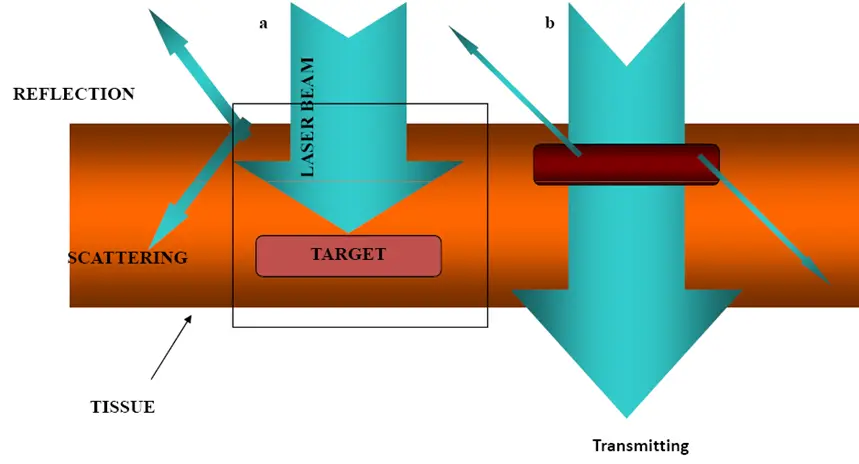
- Laser light waves penetrate the skin with no heating effect, no damage to skin & no side-effects.
- Laser light directs bio stimulative light energy to the body’s cells which convert into chemical energy to promote natural healing & pain relief.
- Stimulation of wound healing
– Promotes faster wound healing/clot formation
–Helps generate new & healthy cells & tissue - Increase collagen production–Develops collagen & muscle tissue
- Increase macrophage activity– Stimulates immune system
- Alter nerve conduction velocity– Stimulates nerve function
- Improved blood circulation & vasodilation
– Increases blood supply - Increases ATP production
- Analgesic effect
– Relieves acute/chronic pain - Anti-inflammatory & anti-edematous effects
– Reduces inflammation
Direct and indirect laser effects
Direct effect – occurs from absorption of photons
Indirect effect – produced by chemical events caused by interaction of photons emitted from laser and the tissues
